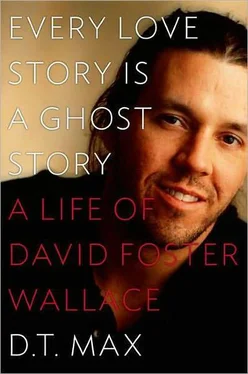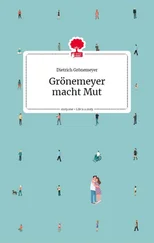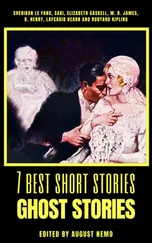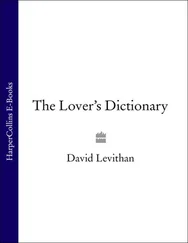The American generation born after, say, 1955 is the first for whom television is something to be lived with , not just looked at. Our parents regard the set rather as the Flapper did the automobile: a curiosity turned treat turned seduction. For us, their children, TV’s as much a part of reality as Toyotas and gridlock. We quite literally cannot “imagine” life without it.
There was more than a bit of self-reference in this point: if anyone couldn’t imagine life without TV, it was Wallace. But the personal was becoming the societal for Wallace, and in his cosmology, TV was an enormous force. It had already remade narrative by breaking stories up into short, palatable, and reassuring segments. Everything from our myths to our relationships was succumbing to this great dispenser of pabulum.
Wallace believed the “three dreary camps” of current fiction writers corresponded to three different responses to this insidious force. One camp consisted of the young hip brat pack writers like McInerney and Ellis, whom he defined as practicing “Neiman-Marcus Nihilism, declaimed via six-figure Uppies and their salon-tanned, morally vacant offspring.” A second camp were the minimalists. He characterized their style as “Catatonic Realism, a.k.a. Ultraminimalism, a.k.a. Bad Carver.” And the third was just about every other writer he’d ever read, especially those favored by his teachers at Arizona. These writers practiced
Workshop Hermeticism, fiction for which the highest praise involves the words “competent,” “finished,” “problem-free”: no character without Freudian trauma in accessible past, without near-diagnostic physical description; no image undissolved into regulation Updikean metaphor; no overture without a dramatized scene to “show” what’s “told”; no denouement prior to an epiphany whose approach can be charted by any Freitag [sic] on any Macintosh. 15
Wallace allowed that some critics might see minimalism or postmodernism as attempts to escape the prison of modern television-shaped reality, but he argued forcefully that they were each too limited to solve the problem:
Both these forms strike me as simple engines of self-reference (Metafiction overtly so, Minimalism a bit sneakier); they are primitive, crude, and seem already to have reached the Clang-Bird-esque horizon of their own possibility.
For Wallace, the great flaw of most fiction was that it was content to display the symptoms of the current malaise rather than to solve it. Wallace wasn’t even sure exactly what fiction that surmounted television-mediated reality would look like, but he believed that any writer who figured it out would sound different from one who didn’t:
If one can stomach a good dose of simplification…there can be seen one deep feature shared by all the cutting-edge fiction that resonates with the post-Hiroshima revolution. That is its fall into time, a loss of innocence about the language that is its breath and bread. Its unblinking recognition of the fact that the relations between literary artist, literary language, and literary artifact are vastly more complex and powerful than has been realized hitherto. And the insight that is courage’s reward — that it is precisely in those tangled relations that a forward-looking, fertile literary value may well reside. 16
Of course readers who knew his recent work from magazines would realize that this wasn’t a bad description of the stories Wallace had collected in Girl with Curious Hair , but Wallace could hardly put himself forward as an ideal anymore: he wasn’t writing and even worse, just as the article was appearing, it was becoming clear the volume of stories his essay was meant to gloss were not going to come out. His prolegomenon would have no follow-up.
As the spring of 1988 passed, Wallace’s thoughts turned again to Arizona. If he could get back there, he became increasingly hopeful, he could return to the work and the pleasure in the work he had known during his previous stay. Even if the creative writing professors at the university there did not want him, the undergraduate writing program staff still remembered his extraordinary teaching and the award he’d gotten. They were happy to have him back as an instructor, to start in the fall. Wallace decided to go west in May, rather than spend the summer months as an overgrown child in his parents’ house. “I miss the heat and the plethora of feminine pulchritude,” he wrote Corey Washington, acknowledging that “I return less than triumphant to Tucson.”
In Tucson, Wallace first stayed with Heather Aronson’s sister Jaci, in a house with a swamp cooler. He slept in the living room, where there was a stereo, so he could listen to meditation tapes he had brought. He ate all the Pop-Tarts in the house and tried to give his hostess money for them and never unpacked his computer, saying he was worried about the humidity.
With Heather’s help, Monica’s, a local bakery, hired him. His job was to come in early and prepare the sourdough bread for baking. The proprietors loved his company, Aronson remembers — Wallace could turn on his “jus’ folks” quality when he wanted to. And he found relief in the physical labor — it requires a lot of upper body strength to stir sourdough mixture. “I mark time by the number of headbands I soak and have to put in the sink,” he wrote Nadell in July, with some satisfaction. But within he was unhappy, nervous, and felt now like whatever could go wrong would. He wanted to know what had happened to the Jeopardy! story that the Paris Review had taken almost a year before. It had been awarded the John Train humor prize and $1,500, money he could use. “Do you suppose,” he asked his agent, “they decided I was playing a joke on them with the story and decided to play an even crueler one on me?” He did not realize or had forgotten that the story had come out in the spring, while he was explaining himself to the Viking Penguin lawyers.
He spent time with Rich C. It was he who had sent Wallace the tapes, actually testimonials by Bob Earl, an alcoholic whose talks on faith and recovery had inspired many addicts. Rich C. was a member of a more focused recovery group than the Urbana one Wallace had attended. They derided the therapy-like techniques of such chapters as, he recalls, “tissues and issues.” The members of the Tucson chapter, were, by contrast, “Big Book fundamentalists” who emphasized a careful adherence to the twelve steps to sobriety that the founding text of alcohol recovery prescribed.
Rich C. became Wallace’s sponsor in the Tucson chapter, the more experienced recovering addict to whom he could turn for practical and spiritual help. One step in the program required the alcoholic to make “a searching and fearless moral inventory” of his life and all the decisions that had gotten him to this point — this Wallace did in a ten-hour-long monologue in which he recounted to Rich C. everything from his childhood anxieties to the troubles in his parents’ marriage to his worries about not being able to write. Another step required the alcoholic to apologize to people he had harmed. Wallace went to see Ostheimer and said he was sorry, explaining that there had been another woman waiting in San Francisco the weekend he had left her and that he suffered from a sex addiction. He wrote to Professor Kennick at Amherst and admitted that, against the rules, he had consulted secondary sources for papers he’d written in his class. He sent Dale Peterson money for the alcohol drunk from his cabinet. “I’m enclosing a small but I think accurate sum to reimburse you for liquor-losses,” he wrote, saying it would be “a personal favor” if Peterson took the money. “This stuff is no fun,” he added, “but I absolutely ran out of rope last winter, and I simply have got to find a different way to live.” He said the group he had joined “has an incredibl[e] success rate for people even more f — ed up than I, and I am just doing what they tell me.”
Читать дальше












